Huntsville, Alabama, Hgh State Clinic, Hgh Injections, Hrt Doctors
Huntsville, Alabama Blood Testing Facilities
 Represents a LabCorp blood testing facility
Represents a LabCorp blood testing facility Represents a Quest Diagnostics blood testing facility
Represents a Quest Diagnostics blood testing facility

Nearby Labcorp Blood Testing facilities:
- Labcorp Center Distance: 0 m, 301 Governors Dr Sw Suite 110, Huntsville, Madison County, AL, 35801
- Labcorp Center Distance: 2 m, 333 Whitesport Dr Sw Ste 202, Huntsville, Madison County, AL, 35801
- Labcorp Center Distance: 9 m, 1878 Jeff Rd. Ste F, Huntsville, Madison County, AL, 35806
- Labcorp Center Distance: 36 m, 1890 Al Hwy 157 Pob 11 220B, Cullman, Cullman County, AL, 35058
- Labcorp Center Distance: 55 m, 2121 North Locust Avenue, Lawrenceburg, Lawrence County, TN, 38464
- Labcorp Center Distance: 57 m, 2835 Highway 231 N, Shelbyville, Bedford County, TN, 37160
- Labcorp Center Distance: 59 m, 302 S 4Th St, Gadsden, Etowah County, AL, 35901
- Labcorp Center Distance: 61 m, 1122 Bradshaw Dr, Florence, Lauderdale County, AL, 35630
- Labcorp Center Distance: 66 m, 1220 Trotwood, Columbia, Maury County, TN, 38401
- Labcorp Center Distance: 71 m, 3400 Highway 78 E Ste 103, Jasper, Walker County, AL, 35501
- Labcorp Center Distance: 72 m, 5421 Main Street, Spring Hill, Maury County, TN, 37174
- Labcorp Center Distance: 74 m, 2217 Decatur Hwy, Gardendale, Jefferson County, AL, 35071
- Labcorp Center Distance: 76 m, 979 East 3Rd Street Ste 127, Chattanooga, Hamilton County, TN, 37404
- Labcorp Center Distance: 80 m, 320 Branscomb Dr Sw Suite C, Jacksonville, Calhoun County, AL, 36265
- Labcorp Center Distance: 82 m, 6016 Shallowford Rd Ste 200, Chattanooga, Hamilton County, TN, 37421
- Labcorp Center Distance: 84 m, 790 Montclair Road, Birmingham, Jefferson County, AL, 35213
- Labcorp Center Distance: 85 m, 1412 Leighton Ave, Anniston, Calhoun County, AL, 36207
- Labcorp Center Distance: 86 m, 311 W 8Th St Ne, Rome, Floyd County, GA, 30165
- Labcorp Center Distance: 88 m, 2022 Brookwood Medical Ctr Dr Ste 401, Birmingham, Jefferson County, AL, 35209
- Labcorp Center Distance: 94 m, 153 Narrows Pkwy Ste 202, Birmingham, Shelby County, AL, 35242
- Labcorp Center Distance: 95 m, 100 Hospital Court, Calhoun, Gordon County, GA, 30701
Nearby Quest Blood Testing facilities:
- Quest Center Distance: 0 m, 806 Governors Dr Sw, Huntsville, Madison County, AL, 35801-5133
- Quest Center Distance: 2 m, 250 Chateau Drive, Huntsville, Madison County, AL, 35801-3497
- Quest Center Distance: 23 m, 1501 7Th St Se, Decatur, Morgan County, AL, 35601-3378
- Quest Center Distance: 60 m, 2105 Florence Blvd, Florence, Lauderdale County, AL, 35630-2853
- Quest Center Distance: 77 m, 600 N Holtzclaw Ave Ste 210, Chattanooga, Hamilton County, TN, 37404-1204
- Quest Center Distance: 78 m, 536 N. Thompson Lane Ste F, Murfreesboro, Rutherford County, TN, 37129-4301
- Quest Center Distance: 85 m, 2001 Mallory Ln, Franklin, Williamson County, TN, 37067-8233
- Quest Center Distance: 86 m, 901 Leighton Avenue Ste 302, Anniston, Calhoun County, AL, 36207-5703
- Quest Center Distance: 88 m, 513 Brookwood Blvd, Suite 506, Birmingham, US, AL, 35209-6892
- Quest Center Distance: 99 m, 1916 Patterson St, Nashville, Davidson County, TN, 37203-2164
Huntsville Alabama Hormone Replacement Therapy Services
The Conscious Evolution Institute is Huntsville's best source for quality HRT Diagnosis and treatment options. CEI is a licensed and board-certified medical clinic which specializes in Hormone Therapy Solutions designed to enhance health and wellness for men and women 30 years of age and older. We understand how important Hormone Balance is to optimal health and we have the skilled Hormone Doctors that have all of the experience and expertise necessary in order to help you discover which course of treatment will help restore the physiological homeostasis which will help you feel better in both mind and body.
Real Hormone Therapy Provided Legally to You
We provide safe and legal Physician-Mediated HGH and Testosterone Therapy. We will connect you with a local affiliate in the Huntsville metropolitan area that can help us get the health information required to provide responsible treatment on your behalf. We use a multifaceted treatment approach which combines clinically proven HRT Therapy with a lifestyle, exercise, and diet program which ensures maximum results that have left our patients feeling better than they have in years.
Call Today for Information about Testosterone and Growth Hormone Replacement
If Bio-Identical Hormone Therapy sounds appealing to you, and you feel like you may be able to benefit from our potentially life-altering treatments, we urge you to make contact with us today! We have a phone number listed at the top of the page, and we also have a form that you can use to arrange to speak with one of our Hormone Specialists if you have any questions or concerns.
HGH Clinics in Huntsville Alabama
Maintaining good health as you grow older is a challenge. There are a lot of factors involved in how our bodies change as we grow older. Decades of research have shown that one of the most devious factors involved in the deterioration of health with age is HGH Deficiency. Human Growth Hormone is the primary mediator of cellular metabolism in the human body. The hormone is released by the pituitary, where it travels through the body to control and optimize the various organic processes which keep us healthy and full of vitality.
Somatopause Treatment
Age-Related Human Growth Deficiency is also known as Somatopause, and it becomes more likely to be symptomatic with every year that we age beyond thirty. Through the late teens and early 20s, HGH Levels reach an adult plateau that has long been associated with healthy physiological function, and beginning in the late twenties and early thirties, Growth Hormone Levels begin to slowly fade, which leads directly to a variety of symptoms as the decline grows more severe, including a weakened immune system, issues with healing and tissue regeneration, mood imbalance, depression, sleeping problems, unhealthy changes in BMI and Cholesterol, in addition to a variety of other symptoms.
Recombinant HGH Injection Therapy has been proven to relieve issues related to Abnormally Low Growth Hormone Levels, improving normal physical and psychological function and improving health outcomes for patients struggling with Low Growth Hormone Production.
Huntsville Alabama Sermorelin Acetate HGH Alternative
For patients on the fence about HGH Therapy, you may be interested to know about a second form of Growth Hormone Deficiency Treatment known as Recombinant Sermorelin Therapy. For the huge majority of patients with Age-Associated HGH Deficiency, the root source of Hormone Imbalance lies with the Hypothalamus, rather than the Pituitary Gland. The body retains the capacity to produce Human Growth Hormone, but no longer receives the correct Hormone Modulation from the Hypothalamus to provide the body with adequate amounts of the hormone.
Sermorelin works by simulating the function of GH-RH, or Growth Hormone-Releasing Hormone, which directly stimulates the pituitary's output of HGH. Sermorelin is notable for being less expensive than Real HGH, while also providing the body with the ideal production of Human Growth Hormone via biological mechanisms which encourage normal overall Hormone Function.
Prescription Testosterone Therapy in Huntsville Alabama
Testosterone Deficiency is a source of shame and anxitety for millions of men in this country today, but it doesn't have to be that way. There is no reason to be ashamed of reaching out to a Hormone Physician regarding your troubled libido or Erectile Dysfunction, because it is easier than ever to get Testosterone Patches, Creams, and Injections than ever before. With our streamlined process, we can test your Testosterone Levels and ship Low-T Treatment Products to your door.
Andropause is a multifaceted condition which affects muscle mass, increases the risk of obesity and diabetes, and is also associated with psychological dysfunction and high-risk cardiovascular conditions such as Heart Disease and Cardiovascular Disease. Don't let your embarrassment affect your health and quality of life. At the Conscious Evolution Institute, we're here to help!
Huntsville Alabama Hormone Replacement Therapy Services
Huntsville is the second most populous city in the state of Alabama and is located in North-Central Alabama in Madison county, just about two hours to the south of Nashville Tennessee. Huntsville is known as the Rocket City for the central importance of the city with regard to the science of engineering and space flight. It is one of the most important cities for NASA in the United States, and was once home to Wernher Von Braun. The most recognizable landmark in Huntsville is the huge Saturn 5 Rocket that greets visitors to the city coming from the west.
Huntsville Suburbs and Neighborhoods
Suburbs of Huntsville include Gurley, Belle Mina, Madison, Harvest, Meridianville, Brownsboro, and New Hope. Some neighborhoods in Huntsville are Monrovia, Mountain Brook, Jones Valley, Greenwycke Village, and City Center.
NASA and Redstone Arsenal
One of the biggest attractions in Huntsville is the Space and Rocket Center, which is both a museum of space flight and an educational attraction which appeals to children and teenagers interested in NASA. Huntsville is also home to the Redstone Arsenal, which is an army base which is important to the Department of Defense, and houses regiments and personnel from the Department of Defense, the Missile Defense Agency, Aviation and Missile Command, and more.
Huntsville Education
Huntsville is home to two universities: the University of Alabama-Huntsville, and Alabama A&M. A&M is an historically black university located in North Huntsville, and its students are known as the Bulldogs. The University was founded in 1873. It underwent a number of name-changes before finally settling on the current name in 1969. UAH is located in West Huntsville, and they are known as the UAH Chargers. Alabama-Huntsville is notable in the region and nationwide for its excellent engineering program.
All About Huntsville, Alabama Geographic Area
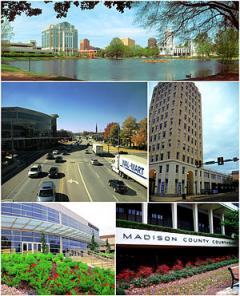
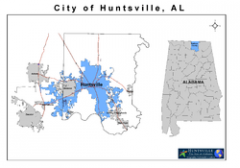
Huntsville is a city located primarily in Madison County in the central part of the far northern region of the U.S. state of Alabama. Huntsville is the county seat of Madison County. The city extends west into neighboring Limestone County. Huntsville's population was 180,105 as of the 2010 Census. The Huntsville Metropolitan Area's population was 417,593. Huntsville is the fourth-largest city in Alabama and the largest city in the four-county Huntsville-Decatur Combined Statistical Area, which in 2008 had a total population of 545,770.
It grew across nearby hills and along the Tennessee River, adding textile mills, then munitions factories, NASA's Marshall Space Flight Center and the United States Army Aviation and Missile Command nearby at the Redstone Arsenal. The National Trust for Historic Preservation named Huntsville to its "America's Dozen Distinctive Destinations for 2010" list.
Revolutionary War veteran John Hunt first settled in the land around the Big Spring in 1805. The area was subsequently purchased by LeRoy Pope, who named the area Twickenham after the home village of his distant kinsman Alexander Pope.
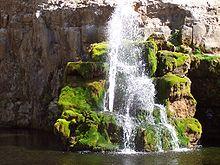
Twickenham was carefully planned, with streets laid out on the northeast to southwest direction based on the Big Spring. However, due to anti-British sentiment during this period, the name was changed to "Huntsville" to honor John Hunt, who had been forced to move to other land south of the new city.
Both John Hunt and LeRoy Pope were Freemasons and charter members of Helion Lodge #1.
In 1811, Huntsville became the first incorporated town in Alabama. However, the recognized "birth" year of the city is 1805, the year of John Hunt's arrival. The city's sesquicentennial anniversary was held in 1955 and the bicentennial was celebrated in 2005.
Huntsville's quick growth was from wealth generated by the cotton and railroad industries. Many wealthy planters moved into the area from Virginia, Georgia, and the Carolinas. In 1819, Huntsville hosted a constitutional convention in Walker Allen's large cabinetmaking shop. The forty-four delegates meeting there wrote a constitution for the new state of Alabama. In accordance with the new state constitution, Huntsville became Alabama's first capital when the state was admitted to the Union. This was a temporary designation for one legislative session only, and the capital was then moved to another temporary location, Cahawba, until the legislature selected Montgomery as the permanent location.
In 1855, the Memphis and Charleston Railroad was constructed through Huntsville, becoming the first railway to link the Atlantic seacoast with the lower Mississippi River.
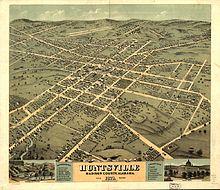
Huntsville initially opposed secession from the Union in 1861, but provided many men for the Confederacy's efforts. The 4th Alabama Infantry Regiment, led by Col. Egbert J. Jones of Huntsville, distinguished itself at the Battle of Manassas/Bull Run, the first major encounter of the American Civil War. The Fourth Alabama Infantry, which contained two Huntsville companies, were the first Alabama troops to fight in the war and were present when Lee surrendered to Grant at Appomattox in April 1865. Eight generals of the war were born in or near Huntsville, evenly split with four on each side.
On the morning of April 11, 1862, Union troops led by General Ormsby M. Mitchel seized Huntsville to sever the Confederacy's rail communications. The Union troops were forced to retreat some months later, but returned to Huntsville in the fall of 1863 and thereafter used the city as a base of operations for the remainder of the war. While many homes and villages in the surrounding countryside were burned in retaliation for the active guerrilla warfare in the area, Huntsville itself was spared because it housed elements of the Union Army.
After the Civil War, Huntsville became a center for cotton textile mills, such as Lincoln, Dallas and Merrimack. Each mill had its own housing community that included everything the mill workers needed (schools, churches, grocery stores, theatres, and hardware stores, all within walking distance of the mill).
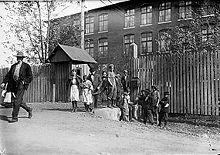
Lily Flagg broke the world record for butter production in 1892, spawning an elaborate party wherein her Huntsville-resident owner General Samuel H. Moore painted his house butter yellow and arranged for electric lights for the dance floor. An area south of Huntsville was named Lily Flagg before 1906. This area was later annexed into the city.
During the 1930s, industry declined in Huntsville due to the Great Depression. Huntsville became known as the Watercress Capital of the World because of its abundant harvest in the area. Madison County led Alabama in cotton production during this time.
By 1940, Huntsville was still a small, quiet town with a population of about 13,000 inhabitants. This quickly changed in early 1941 when 35,000 acres (140 km2) of land adjoining the southwest area of the city was selected by the U.S. Army for building three chemical munitions facilities: the Huntsville Arsenal, the Redstone Ordnance Plant (soon redesignated Redstone Arsenal), and the Gulf Chemical Warfare Depot. These operated throughout World War II, with combined personnel approaching 20,000.
At the end of the war in 1945, the munitions facilities were no longer needed. They were combined with the designation Redstone Arsenal (RSA) and a considerable political and business effort was made in attempts to attract new tenants. One significant start involved manufacturing the Keller automobile, but this closed with only 18 vehicles built. With the encouragement of Senator John Sparkman. the U.S. Army Air Force considered it for a major testing facility, but then selected another site. Redstone Arsenal was then prepared for disposal, but, again with assistance from Senator Sparkman, it was selected for the Army aos rocket and missile development.
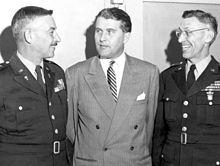
In 1950, about 1,000 personnel were transferred from Fort Bliss, Texas, to Redstone Arsenal to form the Ordnance Guided Missile Center (OGMC). Central to this was a group of German scientists and engineers led by Wernher von Braun that had originally been brought to America by Colonel Holger Toftoy under Operation Paperclip. As the Korean War started, the OGMC was given the mission to develop what eventually became the Redstone Rocket. This rocket set the stage for America aos space program, as well as major Army missile programs, to be centered in Huntsville. Toftoy, then a Brigadier General, commanded OGMC and the overall Redstone Arsenal. In early 1956, the Army Ballistic Missile Agency (ABMA) under Major General John Medaris was formed.
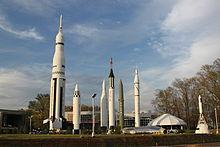
The city is nicknamed "The Rocket City" for its close history with U.S. space missions. On January 31, 1958, ABMA placed America's first satellite, Explorer I, into orbit using a Jupiter C launch vehicle, a descendant of the Redstone. This brought national attention to Redstone Arsenal and Huntsville, with widespread recognition of this being a major center for high technology.
On July 1, 1960, 4,670 civilian employees, associated buildings and equipment, and 1,840 acres (7.4 km2) of land transferred from ABMA to form NASA's George C. Marshall Space Flight Center (MSFC). Wernher von Braun was MSFC's initial Director. On September 8, U.S. President Dwight D. Eisenhower formally dedicated the MSFC.
During the 1960s, the major mission of MSFC was in developing the Saturn boosters used by NASA in the Apollo Lunar Landing Program. For this, MSFC greatly increased its employees, and many new companies joined the Huntsville industrial community. The Cummings Research Park was developed just north of Redstone Arsenal to partially accommodate this industrial growth, and has now became the second largest research park of this type in America.
Huntsville's economy was nearly crippled and growth almost came to a standstill in the 1970s following the closure of the Apollo program. However, the emergence of the Space Shuttle, the International Space Station, and a wide variety of advanced research in space sciences led to a resurgence in NASA-related activities that has continued into the 21st century. In addition, new Army organizations have emerged at Redstone Arsenal, particularly in the ever-expanding field of missile defense.

Huntsville is located at 34 °42 a²N 86 °35 a²W / 34.7 °N 86.583 °W / 34.7; -86.583 (34.7, -86.6). The city has a total area of 202 square miles (520 km2). Recent annexations have moved Huntsville's area into Limestone County a total of 21.5 square miles (56 km2), or 13,885 acres (5,619 ha).
Situated in the Tennessee River valley, several plateaus and large hills partially surround Huntsville. These plateaus are associated with the Cumberland Plateau, and are locally called "mountains". Monte Sano Mountain (Italian for "Healthy Mount") is the most notable, and is east of the city along with Round Top (Burritt), Chapman, Huntsville, and Green Mountains. Others are Wade Mountain to the north, Rainbow Mountain to the west, and Weeden and Madkin Mountains on Redstone Arsenal in the south. Brindlee Mountain is visible in the south across the Tennessee River.
As with other areas along the Cumberland Plateau, the land around Huntsville is karst in nature. The city was founded around the Big Spring, which is a typical karst spring, and many caves perforate the limestone bedrock underneath the surface, as is common in karst areas. The headquarters of the National Speleological Society are located in Huntsville.
The city is bounded by the following places:
The Huntsville city limits expanded west to wrap around and in 2011 fully surround the neighboring city of Madison.

Huntsville has a humid subtropical climate (Koppen climate classification Cfa). It experiences hot, humid summers and generally mild winters, with average high temperatures ranging from 89.4 °F (31.9 °C) in the summer to 48.9 °F (9.4 °C) during winter.
Much of Huntsville's precipitation is delivered by thunderstorms. There are, on average, about 60 days per year during which thunder is reported. Thunderstorms are most frequent during the summer but the most severe storms occur during the spring and - sometimes - fall. These storms can deliver large hail, damaging straight line winds and tornadoes. Huntsville lies in a region of the country which is colloquially known as Dixie Alley, an area more prone to violent, long track tornadoes than most other parts of the US.
On April 27, 2011, one of the largest tornado outbreaks in history, the April 25 ae28, 2011 tornado outbreak, affected the Northern Alabama Area. During this event, an EF5 tornado that tracked near the Browns Ferry Nuclear Power Plant destroyed many transmission towers and caused a multi-day power outage for the majority of North Alabama. Significant Damage from that same tornado was also taken in the Anderson Hills subdivision and in Harvest, Alabama. In total, nine people were killed in Madison County alone and many others injured. Other significant tornado events include the Super Outbreak in 1974, the November 1989 Tornado Outbreak that killed 21 and injured almost 500, and the Anderson Hills Tornado that killed one and caused extensive damage in 1995. On January 21, 2010, Huntsville experienced a rare mid-winter tornado. It registered EF2 on the Enhanced Fujita scale scale and did only moderate damage but received extensive media coverage as it was not rain-wrapped and thus easily photographed.
Since Huntsville is nearly 300 miles (480 km) inland, hurricanes are rarely experienced with their full force; however, many weakened tropical storms cross the area after a U.S. Gulf Coast landfall. While most winters have some measurable snow, significant snow is rare in Huntsville; but there have been some anomalies, like the 1963 New Year's Eve snowstorm, when 17 in (43 cm) fell within 24 hours. Likewise, the Blizzard of 1993 and a Groundhog Day snowstorm in 1996 were substantial winter events for Huntsville. On Christmas Day 2010 Huntville recorded over 4 inches (100 mm) of snow in place, and on January 9 ae10, 2011 Huntsville 8.9 inches (230 mm) at the airport to over 10 inches (250 mm) in the suburbs.
As of the census of 2000, there were 158,216 people, 66,742 households, and 41,713 families residing in the city. The population density was 909.0 people per square mile (351.0/km2). There were 73,670 housing units at an average density of 423.3 per square mile (163.4/km2). The racial makeup of the city was 64.47% White, 30.21% Black or African American, 0.54% Native American, 2.22% Asian, 0.06% Pacific Islander, 0.66% from other races, and 1.84% from two or more races. Hispanic or Latino of any race were 2.04% of the population. Non-Hispanic Whites were 58% of the population in 2010, compared to 86.9% in 1970.
There were 66,742 households out of which 27.6% had children living with them, 45.5% were married couples living together, 13.7% had a female householder with no husband present, and 37.5% were non-families. 32.3% of all households were made up of individuals and 9.2% had someone living alone who was 65 years of age or older. The average household size was 2.29 and the average family size was 2.91. Same-sex couple households comprised 0.5% of all households.
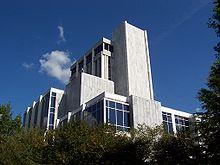
The current mayor of Huntsville is Tommy Battle, who was elected in 2008. The Deputy Mayor/City Administrator is Rex Reynolds, who also serves as the city's Public Safety Director. The city has a five-member/district City Council. The current members are:
Council elections are "staggered", meaning that Districts 2, 3, and 4 had elections in August 2010, while Districts 1 and 5 will have elections simultaneously with mayoral elections in 2012.
The city has boards and commissions which control everything from schools and planning to museums and downtown development.
In July 2007 then Senator Barack Obama held the first fund raiser in Alabama for his Presidential campaign in Huntsville. Obama ended up winning the Alabama Democratic Primary and Madison County by large margins in 2008. However, in the general election, John McCain carried Madison County with 57% of the vote.
See also: List of mayors of Huntsville, Alabama
In 2007, Mayor Loretta Spencer combined the police, fire, and animal services departments to create the Department of Public Safety. The former chief of police was appointed as its director. The new department has nearly 900 employees and an annual budget of $63 million.
The Huntsville Fire Department has 19 engine companies, 4 ladder/rescue companies, and 2 hazardous materials companies located in 17 stations throughout the city of Huntsville. Many Huntsville firefighters are members of the regional Hazardous Materials and Heavy Rescue response teams. The day-to-day operations of the department are currently carried out by the department's Fire Chief.
Huntsville Emergency Medical Services Inc.(HEMSI) provides emergency services to Huntsville and surrounding Madison county. HEMSI operates 17 ALS ambulance crews, 2 BLS ambulance crews, and 1 wheel chair transport from 12 stations located in Huntsville and Madison County. HEMSI also operates 1 ALS ambulance crew at The Marshall Space Flight Center located on Redstone Arsenal.
The Huntsville Police Department has 3 precincts and 1 downtown HQ, 360 sworn officers, 150 civilian personnel, and patrols an area of 194.7+ square miles (this number has grown due to recent annexations).
The Huntsville Police Academy is one of the oldest police academies in the United States. As of 2009, the academy has graduated 50 basic classes and 47 lateral ones.
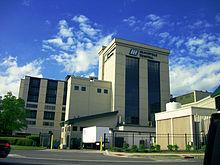
Huntsville's main economic influence is derived from aerospace and military technology. Redstone Arsenal, Cummings Research Park (CRP), and NASA's Marshall Space Flight Center comprise the main hubs for the area's technology-driven economy. CRP is the second largest research park in the United States and the fourth largest in the world. University of Alabama in Huntsville is a center for technology and engineering research in the area. There are commercial technology companies such as the network access company ADTRAN, computer graphics company Intergraph and design and manufacturer of IT infrastructure Avocent. Telecommunications provider Deltacom, Inc. is based in the city. Cinram manufactures and distributes 20th Century Fox DVDs and Blu-ray Discs out of their Huntsville plant. Sanmina-SCI has a presence in the area. Fifty-seven Fortune 500 companies have operations in Huntsville.
In 2005, Forbes Magazine named the Huntsville-Decatur Combined Statistical Area as 6th best place in the nation for doing business, and number one in terms of the number of engineers per total employment. In 2006, Huntsville dropped to 14th; the prevalence of engineers was not considered in the 2006 ranking.
There are several strip malls and shopping malls throughout the city. Huntsville has two enclosed malls aeMadison Square Mall, built in 1984, and Parkway Place, built in 2002 on the site of the former Parkway City Mall. There is a lifestyle center called Bridge Street Town Centre, completed in 2007, in Cummings Research Park.
Huntsville remains the center for rocket-propulsion research in NASA and the Army. The Marshall Space Flight Center has been designated to develop NASA's future Space Launch Vehicle (SLV), and the U.S. Army Aviation and Missile Command (AMCOM) is responsible for developing a variety of rocket-based tactical weapons.
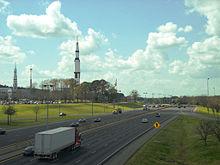
Huntsville is served by several U.S. Highways, including 72, 231, 431 and an Interstate highway spur, I-565, that links the two cities of Huntsville and Decatur to I-65. Alabama Highway 53 also connects the city with I-65 in Ardmore, Tennessee. Major roadways include University Drive, Governors Drive, Airport Road, Memorial Parkway and Research Park Blvd.
Public transit in Huntsville is run by the city's Department of Parking and Public Transit. The Huntsville Shuttle runs 11 fixed routes throughout the city, mainly around downtown and major shopping areas like Memorial Parkway and University Drive and has recently expanded some of the buses to include bike racks on the front for a trial program. A trolley makes stops at tourist attractions and shopping centers. The city runs HandiRide, a demand-response transit system for the handicapped, and RideShare, a county-wide carpooling program.
Huntsville has two active commercial rail lines. The mainline is run by Norfolk Southern, which runs from Memphis to Chattanooga, Tennessee. The original depot for this rail line, the Huntsville Depot still exists as a railroad museum, though it no longer offers passenger service.
Another rail line, formerly part of the Louisville and Nashville Railroad (L&N), successor to the Nashville, Chattanooga and St. Louis Railway (NC&StL), is being operated by the Huntsville and Madison County Railroad Authority (HMCRA). The line connects to the Norfolk Southern line downtown and runs 13 miles (21 km) south, passing near Ditto Landing on the Tennessee River, and terminating at Norton Switch, near Hobbs Island. This service, in continuous operation since 1894, presently hauls freight and provides transloading facilities at its downtown depot location. Until the mid-fifties, the L&N provided freight and passenger service to Guntersville and points South. The rail cars were loaded onto barges at Hobbs Island. The barge tows were taken upstream through the Guntersville Dam & Locks and discharged at Port Guntersville. Remnants of the track supporting piers still remain in the river just upstream from Hobbs Island. The service ran twice daily. L&N abandoned the line in 1984 at which time it was acquired by the newly-created HMCRA, a state agency.
A third line, the Mercury and Chase Railroad, runs 10-mile (16 km) weekend tourist rides on part of another former NC&StL and L&N line from the North Alabama Railroad Museum's Chase Depot, located in the community of Chase, Alabama. The rail line originally connected Huntsville to NC&StL's Nashville-to-Chattanooga mainline in Decherd, Tennessee. The depot was once the smallest union station in the United States when it served the NC&StL and Memphis and Charleston Railroad, the predecessor to the Norfolk Southern.
There are a number of bicycle routes in the city.
Electricity, water, and natural gas are all provided in Huntsville by Huntsville Utilities (HU). HU purchases and resells power from the Tennessee Valley Authority. TVA has two plants that provide electricity to the Huntsville area- Browns Ferry Nuclear Power Plant in Limestone County and Guntersville Dam in Marshall County. A third, Bellefonte Nuclear Power Plant in Jackson County, was built in the 1980s but was never activated. Due to the rapid growth of the region, TVA has plans to eventually activate the plant.
Telephone service in Huntsville is provided by Deltacom, Inc., AT&T, Knology and Comcast. Huntsville has 2 cable providers in the city limits: Comcast and Knology (Mediacom in rural outlying areas). AT&T announced the start of its DSL U-verse service in the Huntsville Decatur metro area on November 1, 2010.
The inland Port of Huntsville combines the Huntsville International Airport, International Intermodal Center, and Jetplex Industrial Park. The intermodal terminal transfers truck and train cargo. The port has on-site U.S. Customs and USDA inspectors and is Foreign Trade Zone No. 83.
Huntsville International Airport is served by several regional and national carriers, including Delta Air Lines, US Airways, United Airlines, American Airlines, and AirTran Airways. Delivery companies have hubs in Huntsville, making flights to Europe, Asia, and Mexico.
The Huntsville Times has been Huntsville's only daily newspaper since 1996, when the Huntsville News closed. Before then, the News was the morning paper, and the Times was the afternoon paper until 2004. The Times has a weekday circulation of 60,000, which rises to 80,000 on Sundays. Both papers were owned by the Newhouse chain. In May 2012, Advance Publications, owner of the Times, announced that the Times, along with the other three newspapers owned by Advance, would be published on only three days a week: Wednesday, Friday and Sunday.
A few alternative newspapers are available in Huntsville. The Valley Planet covers arts and entertainment in the Tennessee Valley area. The Redstone Rocket is a newspaper distributed throughout Redstone Arsenal's housing area covering activities on Redstone. Speakin' Out News is a weekly newspaper focused on African Americans. El Reportero is a Spanish-language newspaper for North Alabama.
Huntsville is the 106th largest radio market in the United States. Station KIH20 broadcasts the National Weather Service's forecasts and warnings for the Huntsville area.
The Huntsville DMA serves 15 counties in North Alabama and 6 counties in Southern Middle Tennessee.
There are 6 movie theaters located in Huntsville.
A few feature films have been shot in Huntsville, including 20 Years After (2008, originally released as Like Moles, Like Rats), Air Band (2005), and Constellation (2005). Portions of the film SpaceCamp (1986) were filmed at Huntsville's U.S. Space and Rocket Center at the eponymous facility. The U.S. Space and Rocket Center stood in for NASA in the 1989 movie Beyond the Stars starring Martin Sheen, Christian Slater, and Sharon Stone. Parts of Tom and Huck (1995) were filmed in Cathedral Caverns, located near Huntsville. Following in the motif of the "Rocket City," Columbia Pictures filmed Ravagers (1979) in The Land Trust's Historic Three Caves Quarry, at the U.S. Space and Rocket Center, and on location at an antebellum home located next door to Lee High School. This cult classic starred Richard Harris, Ernest Borgnine, Ann Turkel, Art Carney and Cecily Hovanes.
Huntsville's legacy in the space program continues to draw film producers looking for background material for space-themed films. During the pre-production of the film Apollo 13 (1995), the cast and crew spent time at Space Camp and Marshall Space Flight Center preparing for their roles. Space Camp was mentioned in the film Stranger than Fiction and was featured in a 2008 episode of Penn & Teller: B.S.! on NASA.
The majority of K ae12 students in Huntsville attend Huntsville City Schools. In the 2007 ae2008 school year 22,839 students attended Huntsville City Schools, 77% of all students scored at or above state and national ACT averages, and of the 1279 members of the graduating class, "approximately 92% of the students indicated that they planned to enter a post-secondary institution for further study, 43% obtained scholarship & monetary awards," and "received 2,988 scholarships totaling $33,619,040, had forty-one National Merit Scholars, three National Achievement Scholars, and two perfect ACT scores."
Of the 53 schools in the Huntsville City Schools system in 2007 ae2008, there were:
For grades 6 ae12, there are 11,696 students enrolled in the following schools:
The two magnet elementary schools are the Academy for Academics and Arts and the Academy for Science and Foreign Language. The three magnet middle schools are Williams Technology, The Academy for Academics and Arts, and the Academy for Science and Foreign Language, and the two magnet high schools are Lee High School (Huntsville, Alabama) and New Century Technology High School.
Approximately 21 private, parochial, and religious schools serve students in grades pre-K ae12. There are several accredited private Christian schools in the city. Among them are Pope John Paul II Catholic High School, Faith Christian Academy, Oakwood Adventist Academy, and Westminster Christian Academy. Randolph School is the only independent, private K-12 school in the city.
60% of HCS teachers have at least a master's degree or better.
The following was the disposition of annual funding in 2007: Instructional services - 54%, Instruction support services - 15%, Operation and maintenance - 11%, capital outlay - 8%, auxiliary services - 7%, general administrative services - 3%, and debt and other expenditures - 2%.
Huntsville's higher education institutions include:
The University of Alabama in Huntsville is the largest university serving the greater Huntsville area. The research-intensive university has more than 7,700 students. Approximately half of the university aos graduates earn a degree in engineering or science, making the university one of the largest producers of engineers and physical scientists in Alabama. UAHuntsville has been ranked by the Carnegie Foundation as a very high research institution, placing it among the top 75 public research universities in the nation. UAHuntsville is also ranked as a Tier 1 national university by U.S. News & World Report.
Oakwood University, founded in 1896, is a Seventh-day Adventist university with over 1,800 students and a member institution of the United Negro College Fund. It is one of the nation's leading producers of successful Black applicants to medical schools. The school was USCAA National Basketball Champions (2008) and the winner of the 19th and 20th Honda Campus All-Star Challenge National Championship Tournaments (2008 and 2009).
Various colleges and universities have satellite locations or extensions in Huntsville:
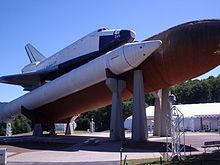

There are 57 parks within the city limits of Huntsville.
The Huntsville Madison County Public Library,[103] founded in 1818, is Alabama's oldest continually operating library system. It has 12 branches throughout the county including one bookmobile. The Main Library Archives contains a wealth of historical resources, including displays of photographic collections and artifacts, has Alabama's highest materials circulation rate, and features daily public programs. The library system provides free public access Internet computers and wireless Internet access in all facilities.
Several arts groups have passed the 50-year mark: Huntsville Community Chorus Association; Huntsville Art League; Theatre Huntsville (through its parent company); Broadway Theatre League; Fantasy Playhouse Children aos Theatre; Rocket City Chorus; Huntsville Symphony Orchestra; and Huntsville Photographic Society among them.
Founded in October 1962 as a non-profit, 501(c)(3) organization, the Arts Council, Inc.[104] (TAC) includes over 100 local arts organizations and advocates. TAC sponsors the arts through five core programs:
TAC promotes the visual arts with two galleries: art@TAC, using the walls near the company aos Von Braun Center[107] offices and the JavaGalleria. TAC supports The Bench Project[clarification needed][108] and the strategic planning effort to support Huntsville-Madison County aos economic development goals through expanded arts and cultural opportunities known as Create Huntsville.[109]
The Von Braun Center, which originally opened in 1975 as the Von Braun Civic Center, has an arena capable of seating 10,000, a 2,000-seat concert hall, a 500-seat playhouse (~330 seats with proscenium staging), and 150,000 square feet (14,000 m2) of convention space. Both the arena and concert hall have undergone major renovations; as a result, they have been rechristened the Propst Arena and the Mark C. Smith Concert Hall, respectively.
Huntsville's sister cities include:
Word Count: 5493






